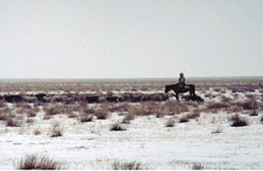 This page has been mothballed.
This page has been mothballed.
It is no longer being updated but we've left it here for reference.
Impact of privatisation on range & livestock management in semi-arid central asia.

- Collaborators
- Overseas Development Institute, London
- Institute of Pasture and Fodder, Kazakstan
- Institute of Sheep Breeding, Kazakstan
- Institute of Animal and Veterinary Husbandry, Turkmenistan
- National Institute of Statistics and Forecasting, Turkmenistan
- Natural Resources Ecology Laboratory, Colorado State University, USA
The purpose of this project, funded by the Department for International Development, is to explore policy options for improving management of livestock and rangelands in Kazakstan and Turkmenistan, undergoing market and land reforms at different paces. Macaulay staff form part of a team of social and biological scientists studying the effect of policy changes on land use, land tenure and household economies.
Part of the Macaulay contribution to the project is to explore the impact of privatisation on livestock nutrition and productivity. This report concentrates on some of the findings in Kazakstan.
In Kazakstan most co-operatives (former collective and state farms) and private farmers cannot now afford to follow the traditional four-season migratory system of sheep management nor to obtain sufficient winter feed of good quality. Small-scale private farmers with less than about one hundred sheep, lack the resources (e.g. family labour, transport) to move animals the long distance between the different pastures. Co-operatives have reduced seasonal livestock movement to two or at most three ecological zones, again due to costs. The large decrease in sheep numbers has meant that there is now excess pasture in all zones, and many sheep now spend the whole year within 10 km of the home village or private farm. However, they need to be supplied with winter fodder since the vegetation ceases to grow in autumn and is often covered in snow from December to March.
 Semi-structured interviews
were conducted with a number of flock owners. Information was collected on the
structure and productivity of the flocks and their nutritional management.
Semi-structured interviews
were conducted with a number of flock owners. Information was collected on the
structure and productivity of the flocks and their nutritional management.
In summer all of the sheep were kept within a few kilometres of the village or barn. All flocks were kept indoors in winter although in some cases the sheep grazed pasture during the day. All sheep were fed hay in winter, cut in June, July and August from either natural or sown pasture, mainly Agropyron spp which had been sown in the past as an improved pasture species. Some flocks were fed concentrate, usually 200-500g barley, in winter.
Flocks which are fed concentrates in winter achieve higher levels of animal performance (Figure 1). The better performing flocks also tended to be the larger flocks. The mean flock size for flocks fed and not fed concentrates were 148 and 18. Owners of small flocks lack the resources to be able to acquire concentrate feed and good quality hay. The numbers of sheep in these small flocks were decreasing because the family needed to slaughter sheep for consumption, barter sheep for household inputs and therefore could not produce sufficient replacements to maintain the flock size. The larger flocks tended to be increasing in size since there were sufficient lambs produced as breeding replacements even after slaughter for consumption and selling or barter.
These preliminary data suggest that under a new, sedentary form of sheep husbandry, the level of winter feeding is a key determinant of sheep productivity. Flock owners suggested that level of nutrition in summer was probably adequate because of the massive destocking that has occurred in Kazakstan in the last 4 years, and the consequent increase in the supply of herbage available for grazing around the villages. Data on plant biomass collected by other team members supports the view that there has been an increase in herbage biomass. This may not, however, be the case in the future if sheep numbers increase.
In the future, more detailed studies of a greater number of flocks are planned to confirm these preliminary findings. These studies will also include flocks which have been moved to the traditional mountain pastures in summer.

